As an Amazon Associate KitchenwareSets.com earns from qualifying purchases.
9 Genius Small Kitchen Layouts That Maximize Every Inch
Feeling like you’re cooking in a closet? You’re not alone.
Small kitchen design is all about maximizing function in limited square footage. The daily frustration of cluttered countertops and zero prep space is a real challenge for many apartment dwellers.
The solution is a smarter layout: a system of clever design choices that maximizes vertical storage, improves workflow, and uses light to create an illusion of space. This guide will show you exactly how to transform your cramped kitchen into a place you love.
Is Your Small Kitchen a Source of Daily Frustration?
If the thought of making dinner brings on a wave of stress, you’ve come to the right place. The constant battle for counter space, the chaos inside cramped cabinets, and the awkward dance around appliances—these are universal small kitchen problems. As someone who has navigated more than one tiny apartment kitchen, I know the struggle is real, but the satisfaction of making it work is even realer.
The core issue in most small kitchens isn’t just the lack of square footage; it’s an inefficient layout that wastes precious inches and creates a frustrating workflow. But there’s good news. Solving this doesn’t require a full renovation. By implementing smart storage solutions, choosing compact elements, and improving lighting, you can create a kitchen that feels organized, spacious, and joyful to use. This guide is your sourcebook for clever, achievable kitchen ideas for small apartments that turn frustration into function.
9 Genius Small Kitchen Layouts That Maximize Every Inch
A great small kitchen layout is more than just deciding where the refrigerator goes. It’s a complete system of smart choices working in harmony to create a space that’s both beautiful and incredibly efficient. The following ideas are packed with actionable steps for both renters and homeowners, all based on proven interior design principles. We’ll focus on ergonomics and the classic “kitchen work triangle”—the connection between your sink, stove, and fridge—to ensure every layout is a model of efficiency.
1. The Efficient Galley Corridor Layout
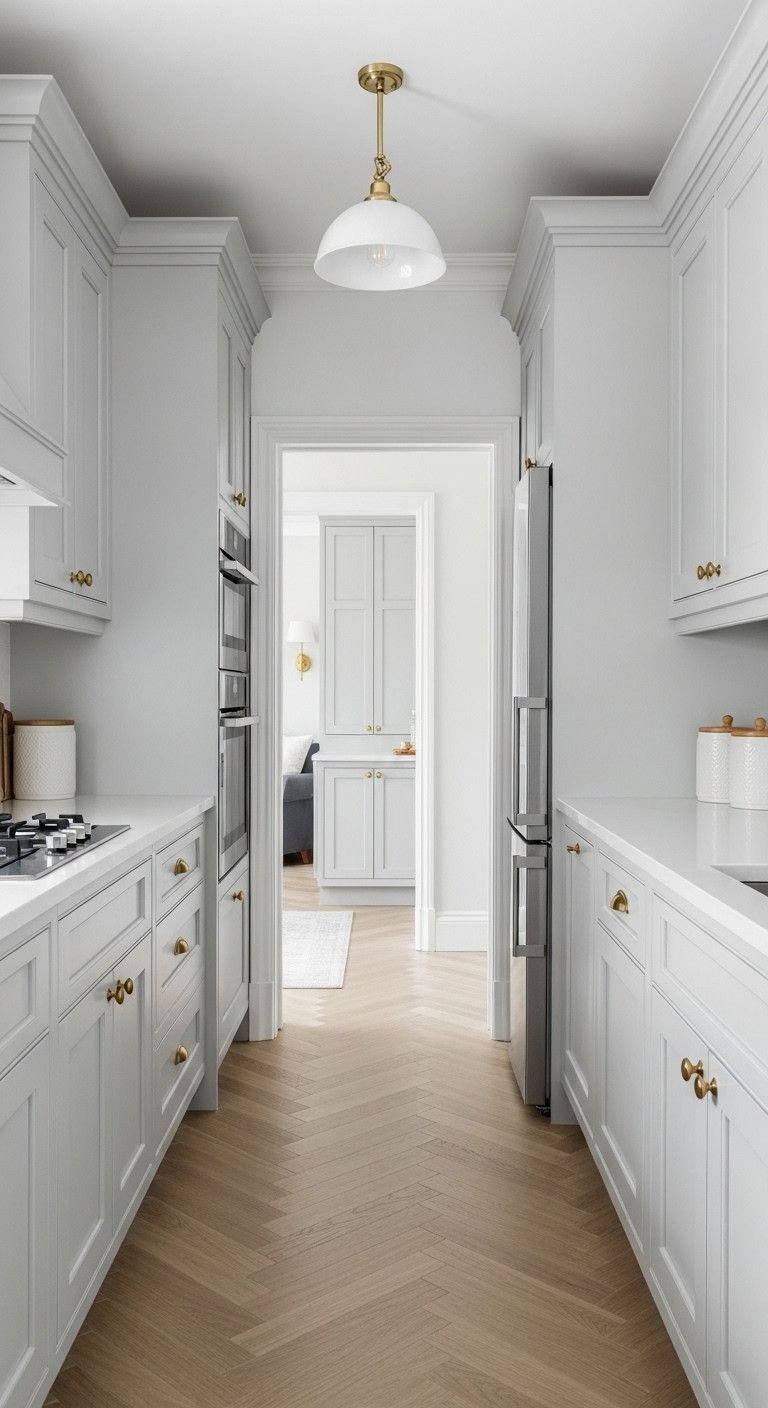
Pin this hyper-efficient layout for your narrow kitchen!
A Galley Kitchen is a classic layout for narrow kitchen solutions, featuring two parallel counters with a walkway in between. It’s the ultimate step-saver, perfect for creating an ergonomic workflow in a tight corridor-style space. The key is to keep the design light and uncluttered to avoid feeling boxed in.
Materials Needed:
- Slim-profile refrigerator: Look for models under 28 inches wide to maximize walkway space.
- Durable runner rug: A long runner adds color and protects floors while defining the walkway.
- Low-profile cabinet hardware: Sleek pulls or knobs prevent snagging clothes in the tight space.
- Light-colored paint: A semi-gloss white or light gray for walls to reflect light.
Step-by-Step Directions:
- Designate Work Zones: Keep your main work triangle (sink, stove, fridge) on one wall if possible to minimize movement. Place less-used items on the opposite wall.
- Maximize Light: Use light colors on both walls and cabinets. If one wall has a window, keep the opposite wall free of bulky upper cabinets to let light circulate.
- Choose Smart Appliances: Opt for counter-depth or slim-profile appliances to gain precious inches of floor space.
- Install a Feature Runner: A visually interesting runner rug can make the space feel longer and more intentional, drawing the eye forward.
Pro-Tip: To avoid a claustrophobic feel, consider removing the doors from some upper cabinets on one side. This creates the illusion of open shelving without the installation work.
2. The Open-Concept L-Shape Corner Layout
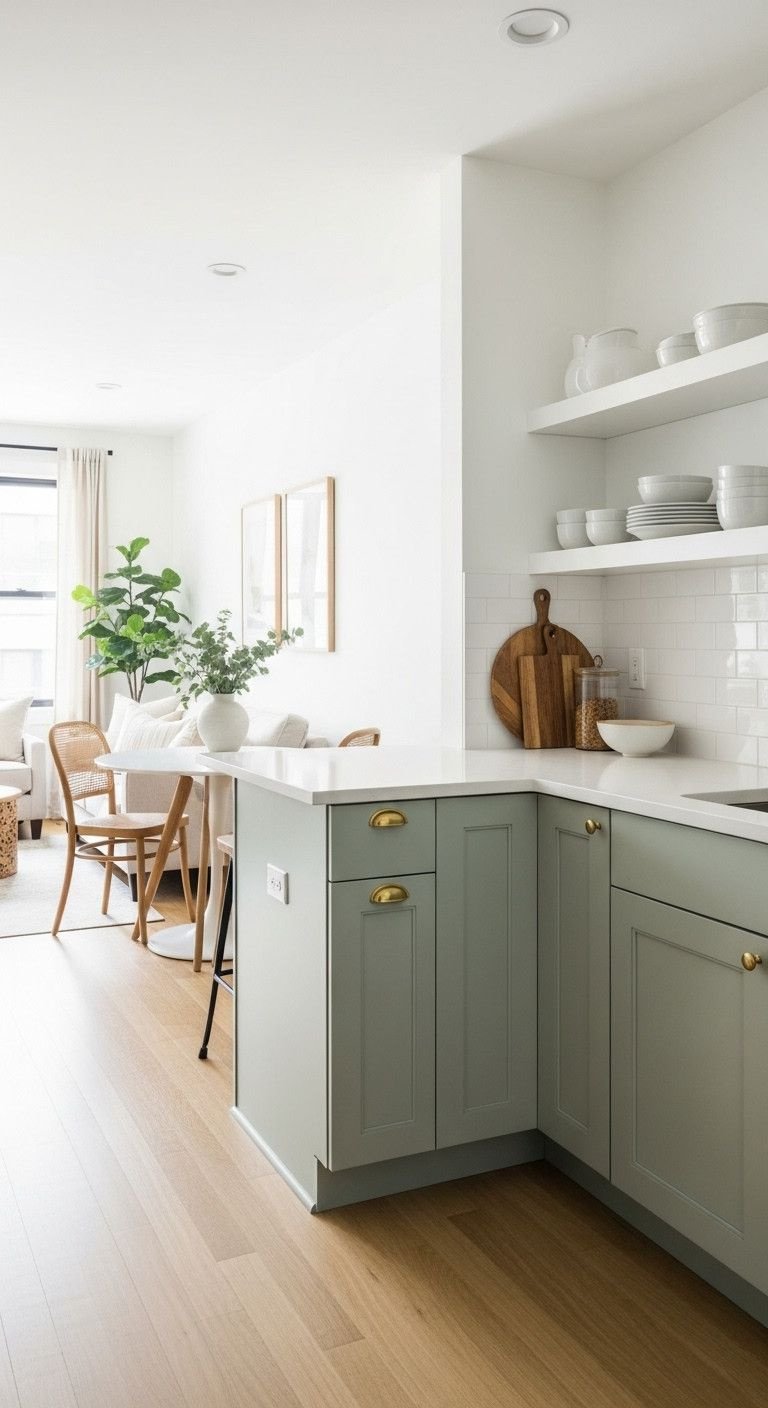
Save this perfect small-space corner kitchen idea!
The small L-shaped kitchen layout is ideal for square rooms or corner spaces in an open-concept apartment. By using two adjacent walls, it naturally opens up the kitchen to the living or dining area, making the entire home feel larger and more social. The secret to this layout is mastering the corner storage.
Materials Needed:
- Corner cabinet organizer: A lazy susan or a blind corner pull-out shelf system is essential to make the corner usable.
- Small bistro table or stools: If extending the counter for a breakfast bar isn’t an option.
- Pendant lights: To hang over a small peninsula or dining area to define the zone.
- Cohesive flooring: Using the same flooring as the adjacent living space makes the whole area feel larger.
Step-by-Step Directions:
- Position the ‘L’: Place the two legs of the ‘L’ along the two available walls, creating an open area for traffic flow.
- Optimize the Corner: This is the most critical step. Install a high-quality lazy susan or pull-out organizer in the corner base cabinet to ensure no space is wasted.
- Create the Work Triangle: Position the sink, stove, and fridge in a tight triangle formation along the two legs for maximum efficiency.
- Define the Space: If space allows, extend one leg of the countertop to create a small peninsula for casual dining. If not, place a small round table just outside the kitchen zone.
Lesson Learned: Don’t skimp on the corner cabinet solution. A cheap or clunky lazy susan will just become a frustrating black hole for pots and pans. Invest in a smooth-gliding pull-out system.
3. The Ultimate Single-Wall Workstation Layout
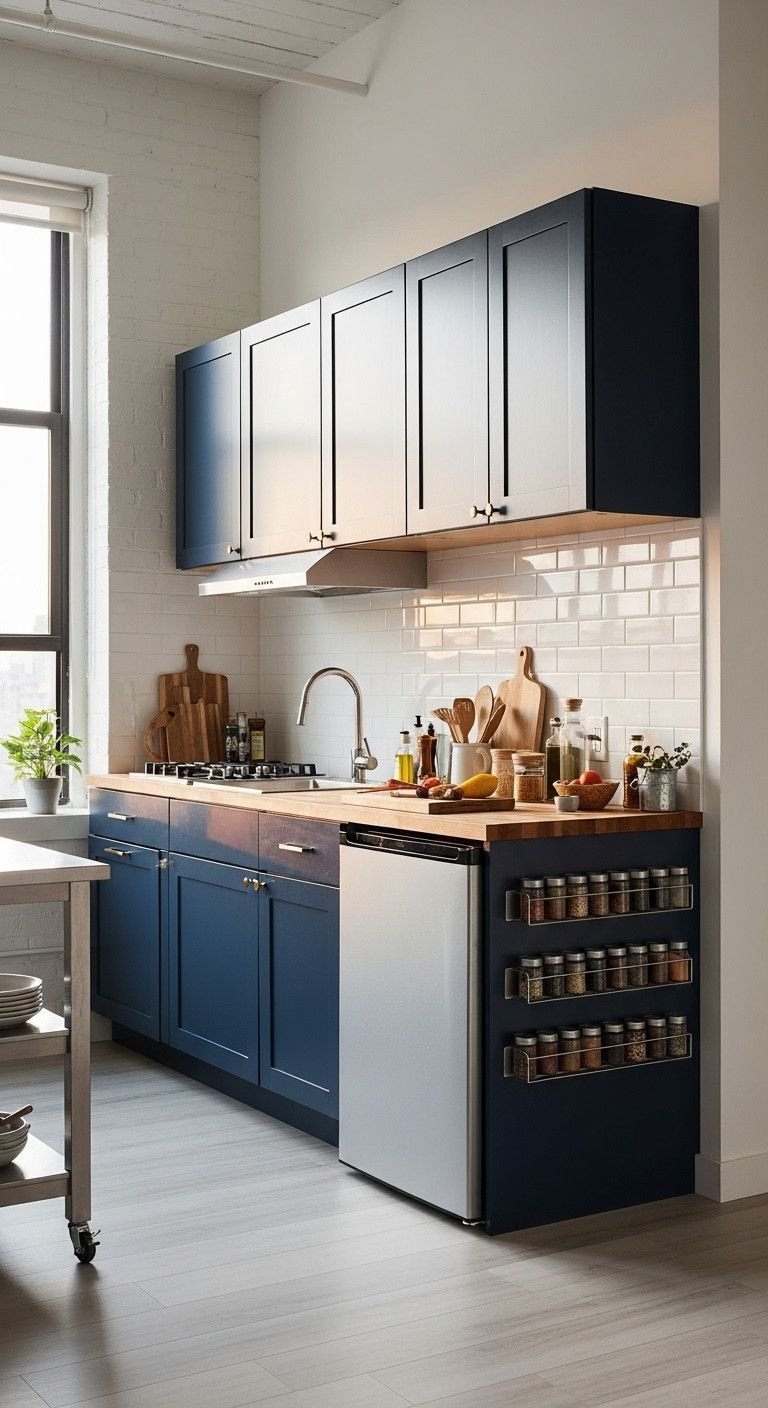
Pin this space-saving single-wall kitchen for your studio!
The single wall kitchen design is the champion of studio kitchen ideas. By containing the entire kitchen—appliances, storage, and counter space—along one linear wall, it frees up maximum floor space for living and dining. This layout requires ruthless efficiency, compact appliances, and a flexible kitchen cart.
Materials Needed:
- Compact appliance suite: An 18″ dishwasher, 24″ fridge, and a 2-burner cooktop or combination microwave/convection oven are key.
- Rolling kitchen cart: A high-quality cart with a butcher block top to act as a movable island for prep space.
- Floor-to-ceiling cabinetry: Maximize vertical space by taking cabinets all the way to the ceiling.
- Integrated sink with cutting board cover: To instantly add usable counter space when the sink isn’t in use.
Step-by-Step Directions:
- Plan the Order: Arrange appliances for a logical workflow. A common order is Fridge -> Sink -> Prep Space -> Cooktop.
- Go Tall: Use tall, narrow pantry cabinets and stack upper cabinets to the ceiling to maximize every vertical inch.
- Select Compact Appliances: This is non-negotiable. Standard appliances will consume all your counter space. Research and invest in a good compact suite.
- Introduce a “Floating” Island: Place a rolling kitchen cart opposite the main wall. It provides crucial prep space and can be moved aside when you need more floor space.
Pro-Tip: Choose handleless cabinets (with push-to-open mechanisms or integrated pulls) to create a seamless, uncluttered look that helps the kitchen wall blend into the living space.
4. The “Go Vertical” Storage Tower Layout
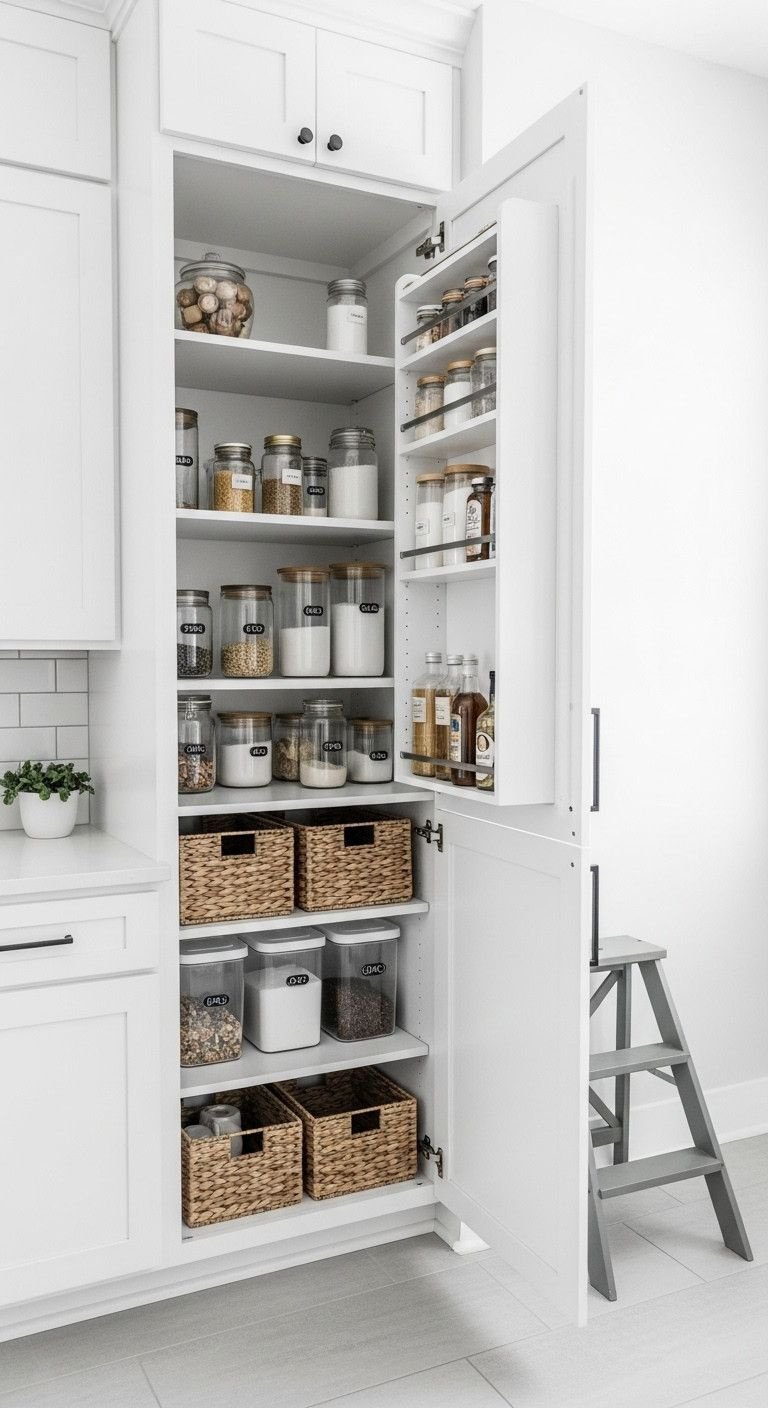
Save this vertical storage idea to conquer clutter!
When you can’t build out, build up. This layout isn’t about the floor plan, but about reclaiming unused vertical space to solve the problem of a lack of pantry space. A tall, narrow pantry cabinet can transform an awkward, empty corner or the end of a countertop into a powerhouse of apartment kitchen organization.
Materials Needed:
- Tall, narrow pantry cabinet: Freestanding units are great for renters; built-ins are a permanent solution.
- Over-the-door organizer: A simple wire or fabric organizer with pockets can add immense storage to the back of a pantry or kitchen door.
- Stackable clear containers: For decanting dry goods like pasta, flour, and cereal to maximize shelf space.
- Small folding step stool: To easily reach the top shelves.
Step-by-Step Directions:
- Identify Vertical Space: Look for an awkward corner, the empty wall at the end of a counter, or the space above your refrigerator.
- Install a Tower Unit: Add a tall, floor-to-ceiling pantry cabinet in the identified space. Even a 15-inch wide unit can hold a surprising amount of food.
- Utilize Door Space: Hang an over-the-door rack on the inside of the new pantry door (or your main kitchen door) for spices, oils, and small items.
- Zone the Interior: Group like items together inside the cabinet. Use baskets for loose snacks and clear containers for bulk goods. Label everything.
Lesson Learned: Don’t just put things on the shelves. Decanting dry goods from bulky packaging into uniform, stackable containers can easily double your usable shelf space.
5. The Airy Open-Shelving Layout
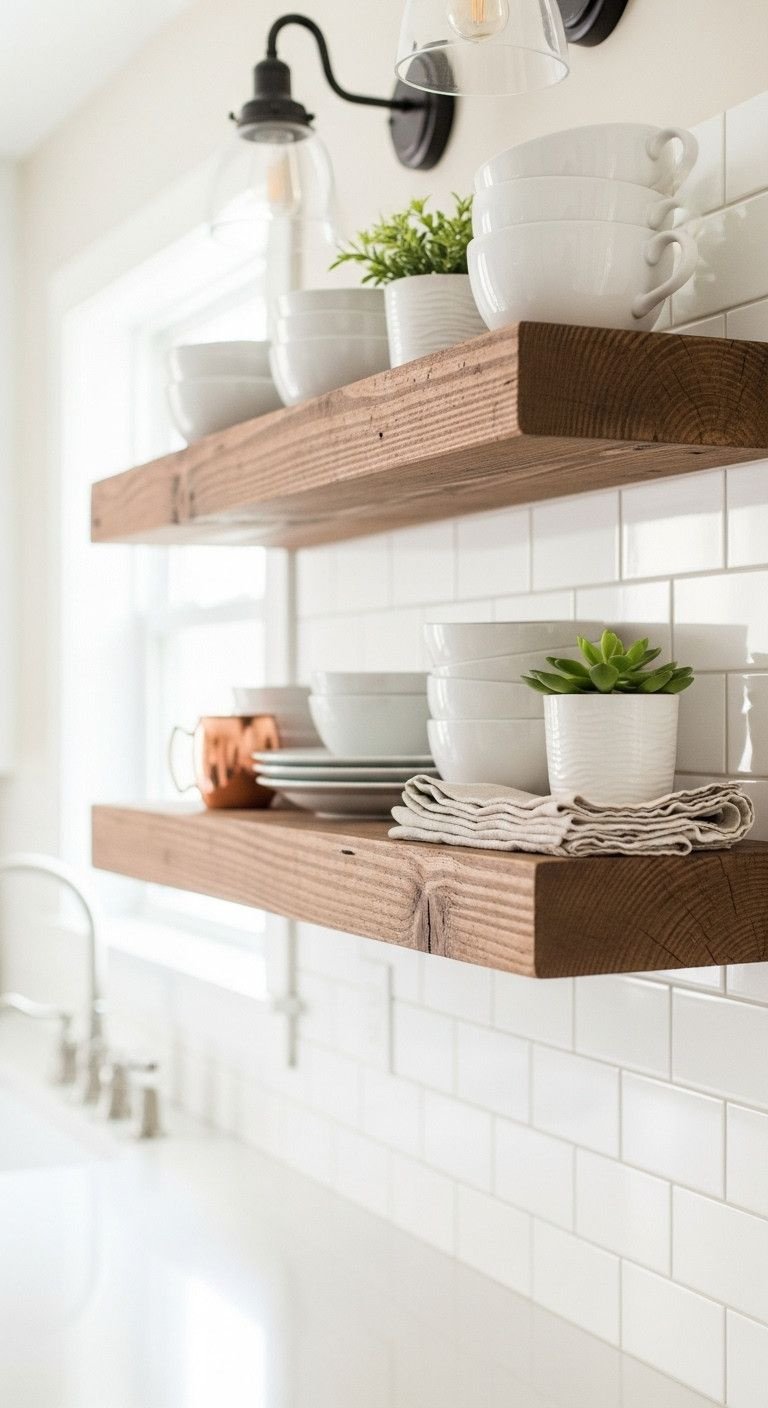
Pin this beautiful open shelving inspiration!
Replacing bulky upper cabinets with open shelving is a powerful trick for making a small kitchen look bigger. Floating shelves have less visual weight, creating an airy, accessible feeling. This approach doubles as small kitchen decor, forcing you to be intentional and curate your collection of dishes and glassware.
Materials Needed:
- Heavy-duty floating shelf brackets: Ensure they are rated to hold the weight of dishes. Always install into studs.
- Thick wood shelves: At least 1.5-2 inches thick for a substantial, high-end look.
- Cohesive dinnerware set: A matching set of plates, bowls, and mugs in a neutral color like white or cream.
- Small decorative items: Potted herbs, small plants, or attractive oil bottles to style the shelves.
Step-by-Step Directions:
- Remove Upper Cabinets: Carefully remove one or two upper cabinets in a highly visible area, like next to a window or over the sink. Patch and paint the wall.
- Install Brackets Securely: Use a stud finder to locate wall studs. This is critical for safety. Mount your heavy-duty brackets directly into the studs.
- Curate Your Collection: This is a display space. Select your most attractive, everyday dishes, glasses, and mugs. Store mismatched or less attractive items in your lower cabinets.
- Style with Intention: Stack items neatly. Group by color and size. Leave some empty space (negative space) so the shelves don’t look cluttered. Add a small plant or piece of art for personality.
Pro-Tip: Start small. If you’re nervous about dust or clutter, just replace one small cabinet with two shelves. Use them for items you use and wash daily, like coffee mugs and cereal bowls.
6. The Light-Bouncing Mirrored Backsplash Layout
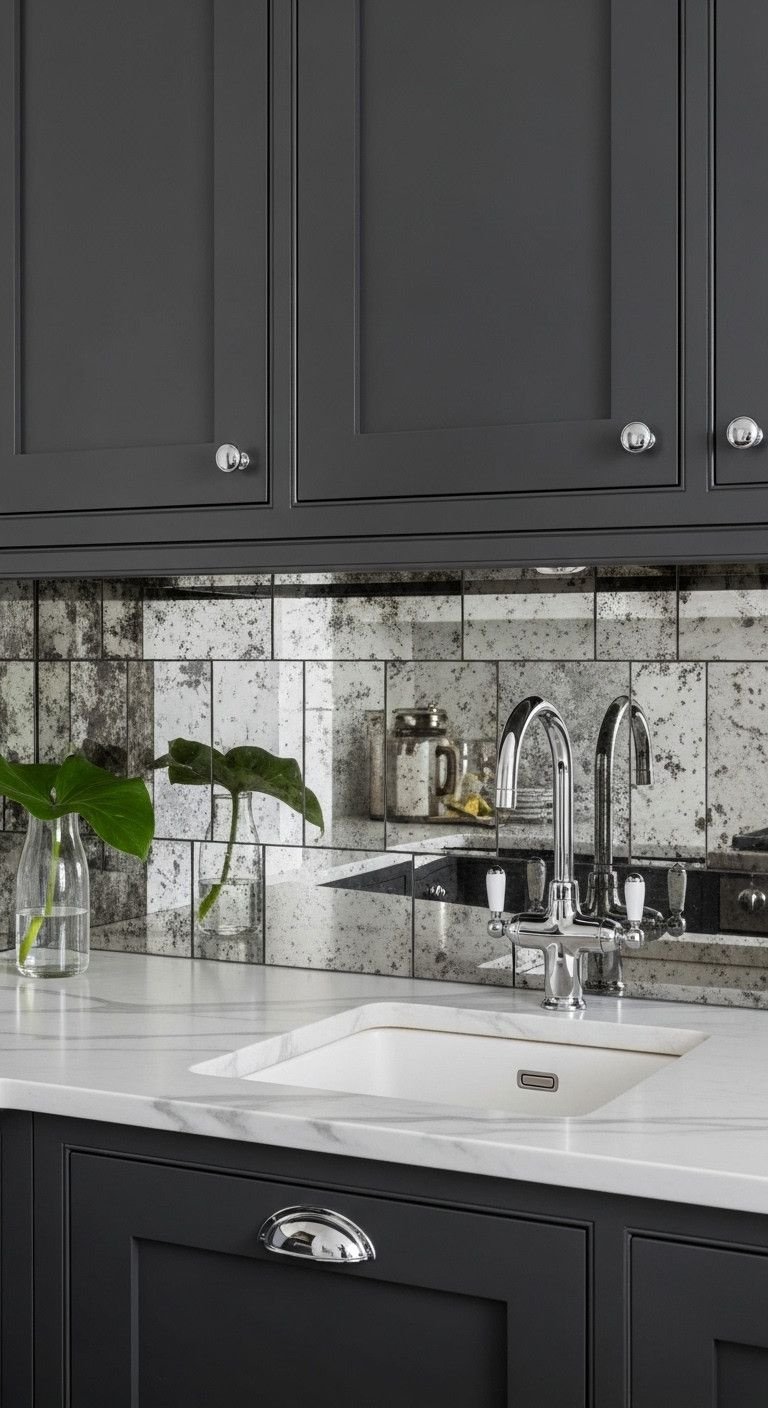
Save this genius tips for making a kitchen look bigger!
This isn’t a traditional layout, but a design tips that transforms space perception. A mirrored backsplash is one of the most effective small kitchen backsplash ideas for creating an illusion of depth. It works by bouncing light around the room and reflecting the space, instantly making your kitchen feel brighter and twice as large. Renter-friendly peel-and-stick options make this an accessible idea for anyone.
Materials Needed:
- Mirrored or antique mirror tiles: For a permanent, high-end installation.
- Peel-and-stick mirror tile sheets: An excellent, non-damaging option for renters.
- Glass cleaner and microfiber cloths: For keeping the surface streak-free.
- Level and tape measure: For ensuring a straight and even application.
Step-by-Step Directions:
- Choose Your Mirror Style: A standard mirror will create the most light, but an antiqued or smoked mirror can hide smudges better and adds a sophisticated look.
- Prep the Wall: Clean the existing wall or backsplash thoroughly to ensure good adhesion for peel-and-stick tiles or tile adhesive.
- Measure and Plan: Measure the area and lay out your tiles on the floor first to plan your cuts, especially around outlets.
- Install Carefully: For peel-and-stick, work in small sections, peeling the backing off as you go and pressing firmly. For real tile, follow standard tiling procedures. A mirrored surface is less forgiving of mistakes, so take your time.
Lesson Learned: A full mirror backsplash can be too much for some. Consider using it in a smaller, strategic area, like behind the sink or cooktop, to get the light-bouncing benefit without being overwhelmed.
7. The Shadow-Busting Under-Cabinet Lighting Layout
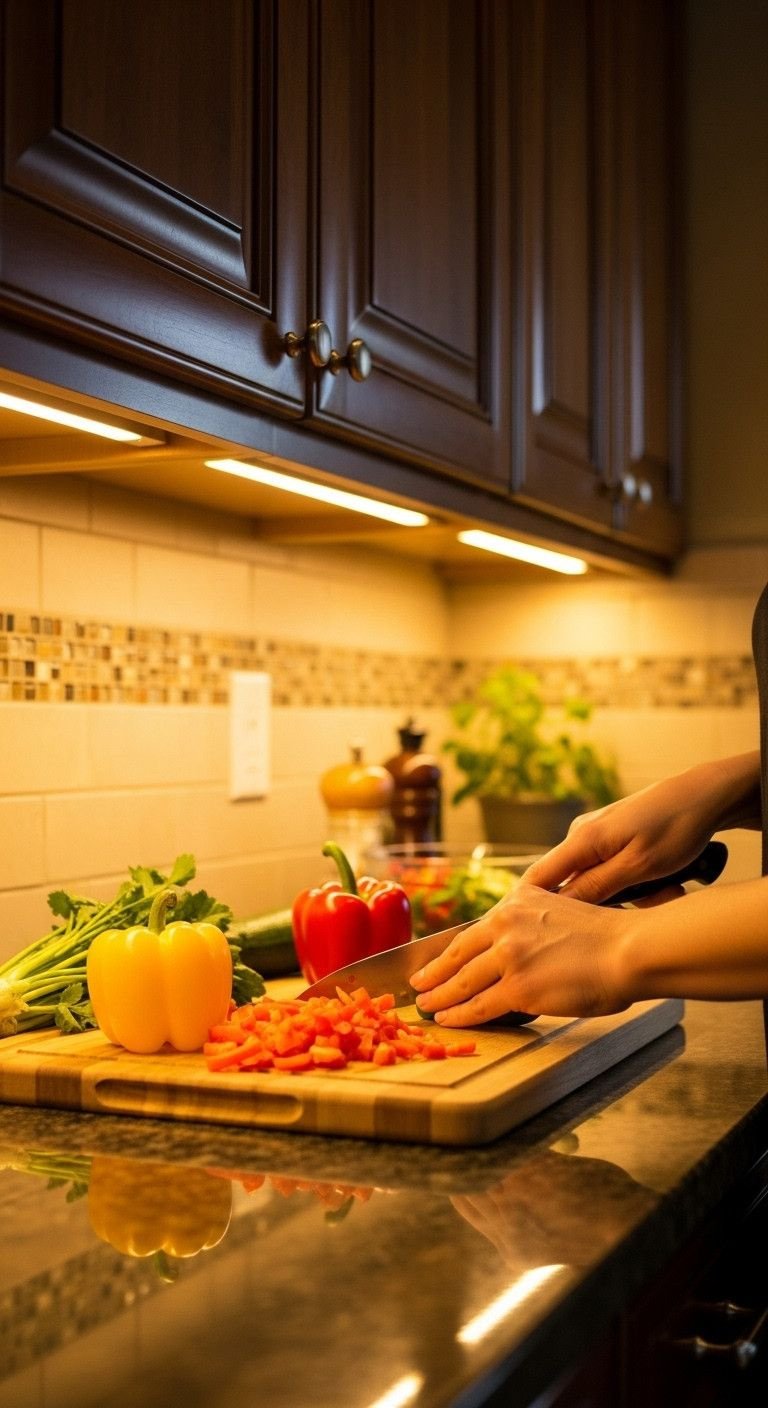
Pin this essential lighting tip for a brighter kitchen!
Good task lighting is a non-negotiable element of functional kitchen design. A single overhead light casts shadows on your countertops exactly where you need to see. Installing under-cabinet lighting is a game-changer that makes your kitchen safer for prep work and creates a warm, inviting ambiance. With modern LED strip lights, this is an easy and affordable DIY project.
Materials Needed:
- LED under-cabinet light kit: Choose between plug-in, hardwired, or rechargeable battery-powered options.
- Measuring tape: To determine the length of lights needed.
- Adhesive clips or screws: To secure the lights and wires.
- Rubbing alcohol: To clean the underside of the cabinets before applying adhesive.
Step-by-Step Directions:
- Choose Your Power Source: For the easiest, renter-friendly option, select a plug-in kit or rechargeable battery-powered LED light bars. Hardwiring is a job for an electrician.
- Select Color Temperature: For a cozy, inviting feel, choose a “warm white” (2700K-3000K). For a brighter, more daylight look, choose “cool white” (3500K-4000K).
- Prep the Surface: Thoroughly clean the underside of your cabinets with rubbing alcohol to remove any grease. This is crucial for the adhesive to stick.
- Install the Lights: Most LED kits have a peel-and-stick backing. Press the light strip firmly into place, positioning it towards the front of the cabinet to best illuminate the counter (not the backsplash). Hide wires using small adhesive clips.
Pro-Tip: Install your lights on a dimmer switch. This allows you to have bright task lighting when you’re cooking and a soft, ambient glow for the evening.
8. The Flexible Rolling Island Layout
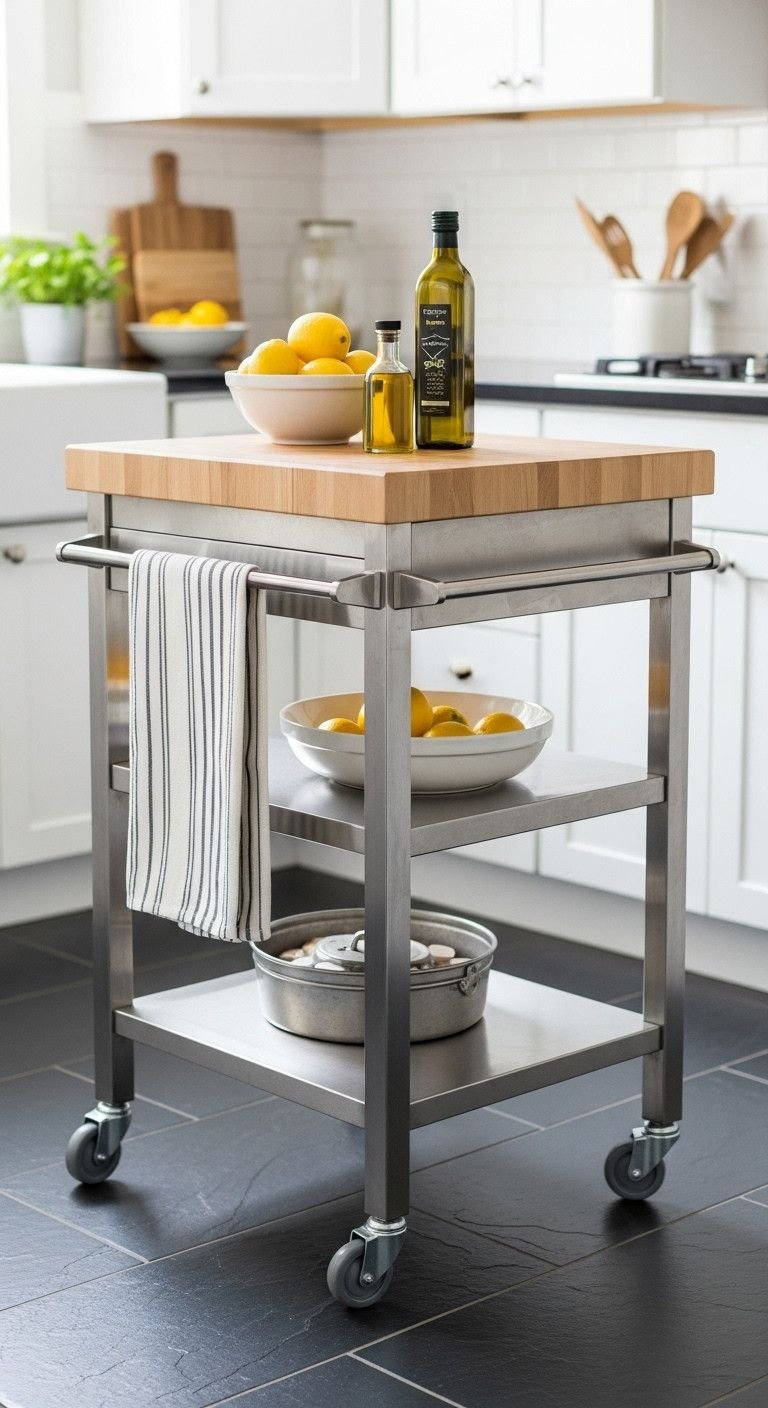
Save this rolling island idea for instant counter space!
If you’re desperately seeking no counter space solutions, a rolling kitchen cart is your new best friend. Unlike a permanent island, a mobile cart offers on-demand prep space and flexible kitchen storage that can be moved aside when you need more floor space. It’s the perfect multi-functional piece for renters or anyone not ready for a renovation.
Materials Needed:
- A rolling kitchen cart: Choose a size that allows for at least 36 inches of clearance around it. Look for features like locking wheels, a towel bar, and shelves or drawers.
- Butcher block conditioner: If you choose a cart with a wood top, to keep it food-safe and prevent cracking.
- S-hooks: To hang utensils or towels from the side of the cart.
Step-by-Step Directions:
- Measure Your Clearance: Before you buy, use masking tape on the floor to mark out the dimensions of the cart you’re considering. Make sure you can still comfortably open appliance doors and walk around it.
- Choose Your Style: Carts come in many styles, from industrial stainless steel to rustic wood. Pick one that complements your existing kitchen decor.
- Assemble and Position: Assemble the cart according to the instructions. Position it in the center of your kitchen for an “island” feel, or at the end of a counter run to act as an extension.
- Load it Up: Use the top for meal prep. Use the lower shelves to store bulky items like a stand mixer or large bowls to free up cabinet space. Lock the wheels when in use for safety.
Lesson Learned: Pay close attention to the height of the cart. Ideally, you want one that is the same height as your existing countertops (usually 36 inches) for a seamless and ergonomic workspace.
9. The Counter-Clearing Wall-Mounted Rail System Layout
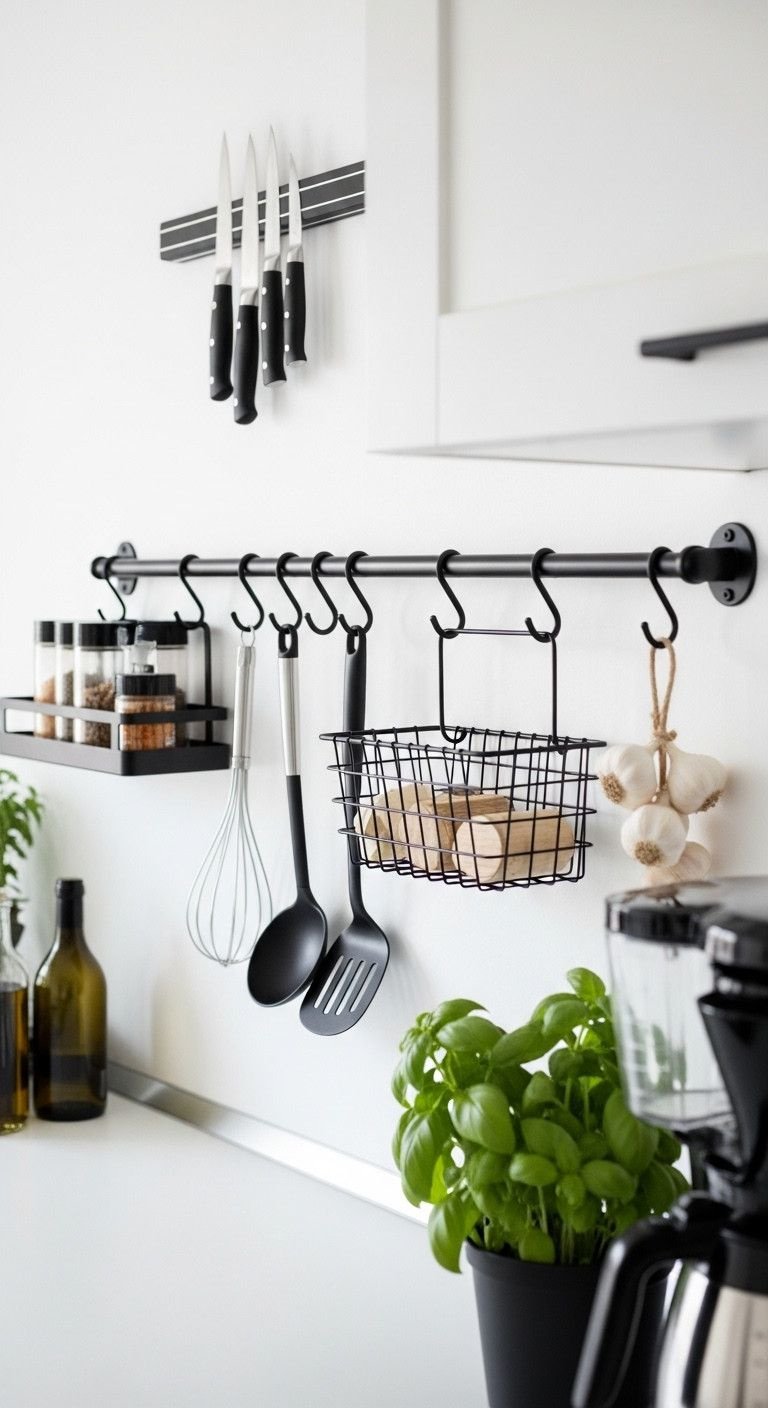
Pin this genius trick for clearing your countertops!
To truly organize a small kitchen, you must conquer cluttered kitchen countertops. A wall-mounted rail system is a simple, high-impact solution that utilizes the empty backsplash space. By getting utensil crocks, spice jars, and knife blocks off the counter, you instantly gain valuable, usable workspace.
Materials Needed:
- Wall-mounted kitchen rail system: Such as the IKEA Kungsfors or similar systems, which include rails, hooks, shelves, and baskets.
- High-powered magnetic knife strip: A safer and more space-efficient option than a countertop knife block.
- Stud finder and drill: To ensure the rails are securely mounted to the wall.
- Small decorative containers: To hold items in the rail system’s baskets or shelves.
Step-by-Step Directions:
- Assess Your Counter Clutter: Identify what’s currently taking up space. Is it a utensil crock? A knife block? A pile of spices? This tells you which rail accessories you need.
- Plan Your Wall Layout: Find a clear section of wall, typically the backsplash area between the counter and upper cabinets. Use painter’s tape to mark where your rail(s) and knife strip will go.
- Install Securely: Use a stud finder to locate studs for the most secure installation. Follow the product instructions to drill and mount the rails and magnetic strip.
- Hang and Organize: Hang your most frequently used utensils (spatulas, ladles, whisks) from S-hooks. Place spices on a small rail-mounted shelf. Arrange your knives on the magnetic strip. Enjoy your newly cleared countertop!
Pro-Tip: Mount the rail system high enough that it doesn’t interfere with small appliances like your toaster or coffee maker, but low enough that you can easily reach everything.
Key Takeaways: Your Quick Guide to a Better Small Kitchen
- Prioritize Layout First: The foundation of a great small kitchen is the layout. Choose a Galley for narrow rooms, an L-Shape for corners, or a Single-Wall for studios.
- Go Vertical: The most underutilized space is between your upper cabinets and the ceiling. Use tall pantry units or shelving to claim this valuable real estate.
- Light is Your Best Friend: Use a combination of light paint colors, reflective surfaces (like a glossy backsplash), and layered lighting (especially under-cabinet) to make the space feel bigger and brighter.
- Clear the Counters: Use wall-mounted rails, magnetic strips, and smart organization to get everyday items off your precious work surfaces.
- Embrace Flexibility: For renters or those on a budget, non-permanent solutions like a rolling kitchen cart or peel-and-stick tiles offer the biggest impact with the lowest commitment.
People Also Ask About Small Kitchen Design
What is the best layout for a very small kitchen?
The best layout depends on your room’s shape. For a long, narrow kitchen, a Galley layout is the most efficient. For a square or corner kitchen, an L-shaped layout is ideal because it opens up the space and creates a great work triangle. For studio apartments, a single-wall layout is the ultimate space-saver.
How can I make my small kitchen look bigger without renovating?
Focus on light and decluttering. Paint walls a light, bright color. Add a mirror or a glossy peel-and-stick backsplash to reflect light. Install battery-powered under-cabinet lights to eliminate shadows. Most importantly, clear everything off your countertops using wall-mounted storage.
What are the best renter-friendly upgrades for an apartment kitchen?
Focus on reversible changes. Use high-quality peel-and-stick tiles for the backsplash or vinyl contact paper for countertops. Swap out cabinet hardware (and save the old ones). Add a rolling kitchen cart for extra storage and prep space. Use tension rods inside cabinets to add extra shelving.
How do I get more counter space in a small kitchen?
Create it or clear it. Add counter space with a rolling cart or an over-the-sink cutting board. Clear existing space by getting rid of clutter. Mount your microwave under a cabinet if possible and use wall rails or magnetic strips to store knives and utensils.
Final Thoughts
A small kitchen does not have to be a frustrating one. As you’ve seen, the limitations of a compact space often lead to the most creative and efficient solutions. With clever planning and by implementing even one or two of these smart layouts and ideas, you can create a kitchen that is not only highly functional but also a genuine joy to cook in.
Which of these small kitchen ideas are you most excited to try in your own home? Let us know in the comments below
Last update on 2025-12-03 at 08:31 / Affiliate links / Images from Amazon Product Advertising API
